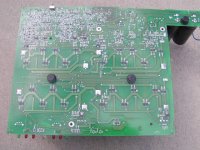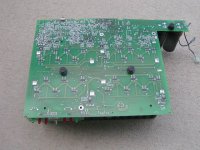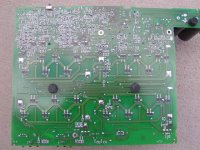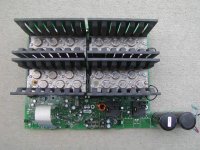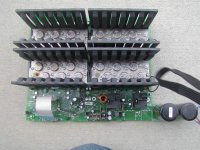Over the years I have often cussed some amplifiers because they were difficult to work on but after finally getting this Crown CL2 out of its chassis I have determined it to be on the top of my list of basturds. Anyone else have a favorite that is on the top of their hate list?
Attachments
Can't remember too many names over the years, but anything where a circuit board is mounted parallel to a panel with a lot of switches and controls, and where you have to disassemble every other part of the amp to get the circuit board away from the panel. A certain Phase Linear preamp comes to mind, but there have been others.
Ho yes!!! The Alchemist Products "The Alchemist" pre amp. I would never touch one again (well not unless the customer offered me a truly obscene amount of money....). This was the top of the range model, designed by myself and a very well known British designer, although neither of us was involved in the styling and production engineering!! (which is where the problem lies)
How about three hours or so just to remove the volume pot? lots of nuts, bolts and socket headed bolts to be removed, many of which required double jointed hands (7 fingers to each hand would help) and have to be removed 100th of a turn at a time with the help of a mirror etc.....
How about three hours or so just to remove the volume pot? lots of nuts, bolts and socket headed bolts to be removed, many of which required double jointed hands (7 fingers to each hand would help) and have to be removed 100th of a turn at a time with the help of a mirror etc.....
Old (around 1980) Audio Pulse time delay with amplifier. The chassis was a single sheet of steel with the sides folded up from the bottom (not removeable.) The output transistors (TO-220) were rivoted to the sides and the board was mounted with component side up, and solder side down. Needless to say - the whole unit was one large board. (Also a lot of car stereo units - some were great and some were awful to work on)
Oh where to start, Marantz 500 comes to mind, many of the Crowns are real PITAs, the 5000 was especially fun. I once had an old 70s tube guitar amp in the shop can't, remember the name right now, it had a PCB with the solder side facing you and the parts were sandwiched between the board and chassis. The only way to inspect or replace parts was to completely unsolder all of the tube sockets and any other connection to get the board out. I'm rebuilding a Citation 22 right now that's not been too fun. Glad to see "Burnedfingers" is back in the game.
Craig
Craig
A certain Phase Linear preamp comes to mind, but there have been others.
A 4000? I banished mine to the warehouse rather than recap it.
and Carver cube amps.
It went with the Phase Linear although it was working last time I used it which was about 10 years ago.
quote:
That PC board looks familiar. I was given a dead Crown CE2000. Dead because an ace technician had taken the board out of the amp which was supposed to be working. He then attempted to power the board up outside the chassis.
A smart tech would have left sleeping dogs lie and would never attempted to play with this design of an amplifier especially if it were working. Its relatively easy to construct a make shift harness to power any amplifier up. I don't know how anyone could have been that clumsey as to make critical errors in troubleshooting and take out a perfectly good running amplifier. Wait!!! We are talking about Crown here and there not quite the best amp on the block.
Another amp that comes to mind is the Altec 9440. Its a pain in the *** amp to work on and extra care must be taken in order to plug in the driver board correctly. I have seen many of these that have be subject to being one pin off when plugging in the driver board and thus a blown up amp.
That PC board looks familiar. I was given a dead Crown CE2000. Dead because an ace technician had taken the board out of the amp which was supposed to be working. He then attempted to power the board up outside the chassis.
A smart tech would have left sleeping dogs lie and would never attempted to play with this design of an amplifier especially if it were working. Its relatively easy to construct a make shift harness to power any amplifier up. I don't know how anyone could have been that clumsey as to make critical errors in troubleshooting and take out a perfectly good running amplifier. Wait!!! We are talking about Crown here and there not quite the best amp on the block.
Another amp that comes to mind is the Altec 9440. Its a pain in the *** amp to work on and extra care must be taken in order to plug in the driver board correctly. I have seen many of these that have be subject to being one pin off when plugging in the driver board and thus a blown up amp.
A smart tech would have left sleeping dogs lie .....Dead because an ace technician
Smart and ace are not the same. I was being generous with the spelling of the word ace! I asked why he took it apart, and he said that he wanted to see how it works! Now it doesn't.
In all fairness the guys are scrap / surplus dealers who I have known for 40 years. The amp came in with a truckload of junk, and was probably used to drive a shaker table.
The Park guitar amp was in a room full of scrap from the renovation of an Atlantic City casino. There were also several giant Altec horns which had about 2 inches of pidgeon droppings on the top from spending 10 years in a warehouse with broken windows. Likely crushed by now.
Wait!!! We are talking about Crown here and there not quite the best amp on the block.
Back in the early 70's I had a DC300A. One channel would distort, oscillate, and make random rude sounds with no input. Autopsy revealed that there was a wire going to the collector of one of the output transistors that had never been soldered at the factory. After that was fixed it worked great.
The single sided mother board connections to the daughter boards were always problematic.A 4000? I banished mine to the warehouse rather than recap it.
It went with the Phase Linear although it was working last time I used it which was about 10 years ago.
Quote:
Can't say I've ever had any real problems with Crown amps....even the 5000 series (Macrotech?), a bit awkward but not in the same league as the amp I mentioned earlier.
I believe if my memory is correct that the 5000 series didn't have the surface mount parts like the newer series of Crown amps have. Being able to remove and replace defective parts means a lot.
Meanwhile the Crown is still kicking my ***. The output stage check ok in both channels of both of the amps I have.
Can't say I've ever had any real problems with Crown amps....even the 5000 series (Macrotech?), a bit awkward but not in the same league as the amp I mentioned earlier.
I believe if my memory is correct that the 5000 series didn't have the surface mount parts like the newer series of Crown amps have. Being able to remove and replace defective parts means a lot.
Meanwhile the Crown is still kicking my ***. The output stage check ok in both channels of both of the amps I have.
Audio research D100 solid state
A real charmer and one of AR's barking dogs that didn't live long.
Trying to hide input circuitry (AM1 AM2 modules) and TO3 markings (AR#'s) went along way saying I'll make you guess and go ouhh and ahhh...There must be something special here! Didn't pan out at all...
Mostly unreliable design with 16 outputs per channel, unrealized
Nice chassis and heavy duty build, nice to shoehorn another circuit in
There other stuff is nice but not this one.
Regards
David
A real charmer and one of AR's barking dogs that didn't live long.
Trying to hide input circuitry (AM1 AM2 modules) and TO3 markings (AR#'s) went along way saying I'll make you guess and go ouhh and ahhh...There must be something special here! Didn't pan out at all...
Mostly unreliable design with 16 outputs per channel, unrealized
Nice chassis and heavy duty build, nice to shoehorn another circuit in
There other stuff is nice but not this one.
Regards
David
Anything by Behringer. Everything glued with hot-melt that runs into connectors and ribbon cables meaning they often break before they un-mate.
I agree. They're a nightmare to service.
I modified the soft start on an Audio Analogue Maestro mono block.
There are 3 PCBs wired together that have to me removed to get to the soft power supply PCB. For each experiment with resistor values, several wires in the amp had to un-soldered. At least the PCBs are good quality.
Generally speaking, any PCB with thin copper tracks is difficult. Mil spec PCBs rule
There are 3 PCBs wired together that have to me removed to get to the soft power supply PCB. For each experiment with resistor values, several wires in the amp had to un-soldered. At least the PCBs are good quality.
Generally speaking, any PCB with thin copper tracks is difficult. Mil spec PCBs rule
Metaxas Solitaire. Terminally unstable, ultra-fussy component selection, wafer thin boards with molecule thin tracks. Hard to get to, hard to fault find, ludicrously complex. New circuit revision every second Tuesday.
Suffered frequent, expensive and spectacular failure-by-detonation.
Sounded good when working. Sounded explosive otherwise.
A customer once told me "Metaxas is Greek for 'Hand Grenade'"
Suffered frequent, expensive and spectacular failure-by-detonation.
Sounded good when working. Sounded explosive otherwise.
A customer once told me "Metaxas is Greek for 'Hand Grenade'"
I am not servicing amps except special amps, so it is not amp, just ED&D programmable load. It has main boards and modules in slots. To switch 220/110 option or checking fuses, the case should completely opened, with so many screws. then connectors is so many and to plug/unplug them, all (many) slots must be removed and they also so many screws and their screws are different each others, geezz. So many different screws with different length and rings, if any swapped, other won't fit.
- Status
- This old topic is closed. If you want to reopen this topic, contact a moderator using the "Report Post" button.
- Home
- Amplifiers
- Solid State
- Your least favorite amp to work on and why.
